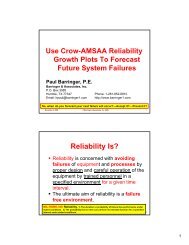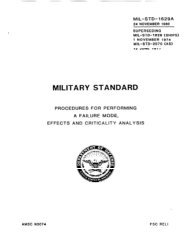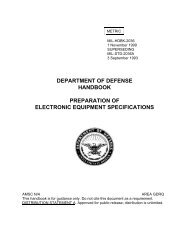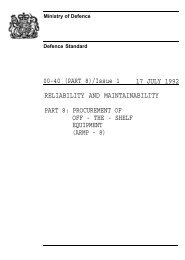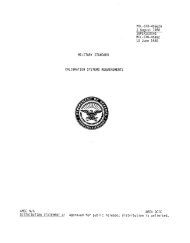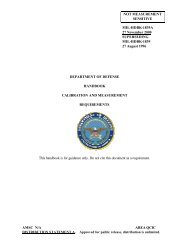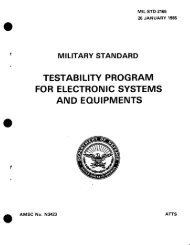Essential Elements of a Successful Reliability Program
Essential Elements of a Successful Reliability Program
Essential Elements of a Successful Reliability Program
Create successful ePaper yourself
Turn your PDF publications into a flip-book with our unique Google optimized e-Paper software.
<strong>Essential</strong> <strong>Elements</strong> <strong>of</strong> a<br />
<strong>Successful</strong> <strong>Reliability</strong> <strong>Program</strong><br />
Paul Barringer, P.E.<br />
Barringer & Associates, Inc.<br />
Humble, TX<br />
Phone: 1-281-852-6810<br />
Email: hpaul@barringer1.com<br />
© Barringer & Associates, Inc. 2012
What Is <strong>Reliability</strong><br />
• <strong>Reliability</strong> is concerned with avoiding<br />
failures <strong>of</strong> equipment and processes—the<br />
process is <strong>of</strong> greater importance than the<br />
equipment as it generates cash!<br />
• Avoid failures by proper design and careful<br />
operation <strong>of</strong> equipment by trained<br />
personnel in a specified environment for a<br />
given time interval—that’s how you get a<br />
failure free environment and reliability.<br />
2
What Is <strong>Reliability</strong>-more<br />
• <strong>Reliability</strong> is mainly a strategic issue—not<br />
a tactical issue.<br />
• Consider this as a reliability policy:<br />
We will build an economical and failure<br />
free process that will operate for 5<br />
years between planned turnarounds.<br />
• So, what does your reliability policy say<br />
3
What Is Maintenance<br />
• Maintenance is concerned with quickly<br />
correcting failures <strong>of</strong>ten driven by a natural<br />
law <strong>of</strong> system entropy changes. Often<br />
failures are driven by MTBSE * rather than<br />
entropy deterioration.<br />
• The aim <strong>of</strong> maintenance is minimizing<br />
maintenance costs and downtime.<br />
• Maintenance is mainly a tactical issue—<br />
not a strategic issue<br />
* Mean Time Between Stupid Events<br />
4
What Is Maintenance--More<br />
• At the start <strong>of</strong> a reliability program you will<br />
need about 10 maintenance engineers for<br />
every 1 reliability engineer.<br />
• With time and reliability successes the<br />
ratio declines from ~10:1 to ~3:1 as<br />
repairs decline.<br />
• Job descriptions * are different for<br />
maintenance and reliability engineers, i.e.,<br />
repair failures vs prevent failures.<br />
* barringer1.com/jobdescriptions.htm<br />
5
Where Do Failures Occur<br />
• Mature Nuclear Power Production Failures<br />
– People 38%<br />
– Procedures + Processes 34%<br />
– Equipment 28%<br />
72% <strong>of</strong> all failures<br />
• 10 Year ASME Boiler Test Code Equipment*<br />
– 23,338 Accidents 83% human oversight or lack <strong>of</strong> knowledge<br />
– 720 injuries 69% human oversight or lack <strong>of</strong> knowledge<br />
– 127 deaths 60% human oversight or lack <strong>of</strong> knowledge<br />
• Engineers--can you really reduce<br />
problems working on only the hardware<br />
* Source: ASME National Board Bulletin, Summer 2002, Volume 57, Number 2, Page 10,<br />
“Ten Years Of Incident Reports Underscore Human Errors As Primary Cause<br />
Of Accidents”, http://nationalboard.org/SiteDocuments/Bulletins/SU02.pdf<br />
6
<strong>Reliability</strong>, Maintenance, and $<br />
• Business is all about making money. This<br />
requires a balanced between avoiding<br />
failure, repairing failures, and keeping the<br />
process operating to make money.<br />
• The ultimate aim <strong>of</strong> business is satisfying<br />
customers with on-time delivery <strong>of</strong> quality<br />
products while producing a long-term<br />
return for satisfying stockholders.<br />
• In the end, reliability and maintenance<br />
are all about money.<br />
7
R, M, & $--more<br />
• Focus your reliability program on money<br />
issues beginning with a $Pareto priority<br />
list. The work list is made from recent<br />
problems and the threat <strong>of</strong> failures.<br />
• Focus on the 10-20% <strong>of</strong> the Pareto items<br />
containing 60-80% <strong>of</strong> the money issues.<br />
• Work on $Pareto things first—not your<br />
love affairs!!<br />
• In the end, it’s all about the money!<br />
8
Pareto Discipline—VIP Status<br />
Winners work<br />
on the vital few!<br />
6.25 Years Of Experience With ~3000 Pieces Of Equipment<br />
20% <strong>of</strong> the number <strong>of</strong> pieces <strong>of</strong> equipment<br />
generate 80% <strong>of</strong> the maintenance costs!<br />
Losers work<br />
on the trivial many!<br />
10% <strong>of</strong> the number <strong>of</strong> pieces <strong>of</strong> equipment<br />
generate 80% <strong>of</strong> the maintenance costs +<br />
economic losses!<br />
Pareto Principle:<br />
10-20% <strong>of</strong> the “stuff” will contribute<br />
60%-80% <strong>of</strong> the $ impact!<br />
9
Management <strong>Essential</strong>s<br />
• Management: Communicate reliability<br />
programs by a policy statement<br />
• Management: Establish discipline in the<br />
spirit <strong>of</strong> train, direct, and mold the<br />
organization for reliability.<br />
• Management: Motivate the organization to<br />
work the $Pareto list <strong>of</strong> failures and threats<br />
for the lowest long-term cost <strong>of</strong> ownership.<br />
10
Management <strong>Essential</strong>s-more<br />
• Management: Organize your team results to<br />
achieve a failure-free environment<br />
• Management: Work for small discrepancies<br />
at every step <strong>of</strong> the process as helping<br />
hands take initiative, without individual<br />
direction, and without waiting for specific<br />
instructions by way <strong>of</strong> empowerment and<br />
enablement <strong>of</strong> work force team work.<br />
11
Management: Empower &<br />
Enable The Workforce<br />
• Empowerment means management<br />
authorizes individual initiative and<br />
experience to be used continuously in an<br />
effective and timely manner.<br />
• Management must invest individuals in the<br />
organization with authority to take action.<br />
• Empowerment and enablement is not<br />
minimum effort for lowest pr<strong>of</strong>iciency levels.<br />
12
Empower & Enable--more<br />
• Enablement means the work force must be<br />
trained and drilled for pr<strong>of</strong>iciency using best<br />
practices for continuous improvement by<br />
feedback from the working teams.<br />
• Management: Build a positive corrective<br />
action organization with a culture <strong>of</strong><br />
confessing errors and correcting errors<br />
without punishment.<br />
13
Empowerment and Enablement<br />
Royal Navy 200 Years Ago<br />
• England ruled the wave for 200 + years with<br />
an empowered and enabled navy.<br />
• Officers gave up management prerogatives<br />
to empowered crews to achieve superior<br />
results in battle.<br />
• Gun crews were enabled by carefully<br />
training and drilling to fire 2 to 3 times more<br />
shells in battle, with greater precision, and<br />
few commands during battle.<br />
14
Royal Navy*--more<br />
• When needed, crew and <strong>of</strong>ficers both lent<br />
their hands to duties in battle without<br />
instructions no US vs THEM conditions.<br />
• Seasoned <strong>of</strong>ficers were required to know<br />
and perform mundane details with great<br />
pr<strong>of</strong>iciency, e.g., show me don’t tell me.<br />
* To Rule The Waves: How the British Navy Shaped the Modern World,<br />
by Arthur Herman, 2004, ISBN: 0-06-053434-9.<br />
15
Modern Example: Empower &<br />
Enable—US Carrier Operations<br />
• You must publically confess your errors<br />
• You are drilled 24/7/365 good or bad weather<br />
• Your peers provide you feedback in public to<br />
make a better, error free, operation<br />
• You get graded on every carrier landing<br />
• Your inferior performance gets Skipper’s help<br />
• The Air Boss, once a year, takes the aviation<br />
team step-by-step through all aviation details<br />
16
Failed <strong>Reliability</strong> <strong>Program</strong>s<br />
• Unsuccessful reliability programs are<br />
bottom-up efforts to improve maintenance<br />
technical details without financial<br />
justifications.<br />
• Bottom-up programs get luke-warm<br />
management endorsement with<br />
condescending management remarks<br />
such as “here we go again with another<br />
gear-head program”.<br />
17
Failed <strong>Program</strong>--more<br />
• Management says yes we’re for reliability<br />
now get that pump repaired faster.<br />
• Emphasis <strong>of</strong> faster repairs rather than<br />
preventing repairs is also a kiss <strong>of</strong> death for<br />
a reliability program.<br />
• Moving reliability programs up the<br />
organization is as effective as pushing a<br />
wet rope. Look for successes <strong>of</strong> ~10-20%.<br />
18
Failed <strong>Program</strong>-more<br />
• Another kiss <strong>of</strong> death is installing a newer<br />
and more complex computerized<br />
maintenance system (CMMS) with loss <strong>of</strong><br />
data from earlier systems.<br />
• New CMMS systems show few immediate<br />
financial results except spending more $’s.<br />
• Continuous improvement is greatly<br />
preferred over postponed perfection!<br />
19
Summary: <strong>Successful</strong> <strong>Program</strong>s<br />
• Make reliability programs money driven--not<br />
technology driven. Sell improvements as<br />
about time and money issues.<br />
• Use reliability tools/technology to reduce lost<br />
money issues.<br />
• Work the $Pareto list based on actual failures<br />
and the $risks <strong>of</strong> possible failures.<br />
$risk = (probability <strong>of</strong> failure)*($consequence)<br />
20
Successes--more<br />
• Discuss the top 10 $Pareto items with<br />
management. Progress is reducing<br />
$losses in months--not years.<br />
• Forecast future $failures for next 3-5 years<br />
using Crow-AMSAA reliability growth plots.<br />
•Use root cause analysis to solve critical<br />
failure issues within the top 10 $items—<br />
Why That’s where the money loss occurs!<br />
21
Successes--more<br />
• Sell management that reliability programs<br />
are to their advantage for changing the site<br />
culture from $failure accepting to preventing<br />
$failures with fact driven engineering effort<br />
with an empowered/enabled work force.<br />
• Encourage individual confessions <strong>of</strong> errors<br />
without punishment—look to the nuclear<br />
industry as an example.<br />
22
Success--more<br />
• Empower and enable your workforce for<br />
better performance.<br />
• Describe improvements in $’s not things.<br />
• Make money for the company by reducing<br />
failures and making improvements. Do it<br />
NOW!<br />
23
Want More <strong>Reliability</strong> Info<br />
•Go to http://www.barringer1.com for:<br />
– <strong>Reliability</strong> engineering job descriptions<br />
– Military/NASA/NUREG reliability documents<br />
– Worked out examples <strong>of</strong> reliability issues<br />
– Historical Weibull reliability documents<br />
– Technical papers on reliability issues<br />
24



